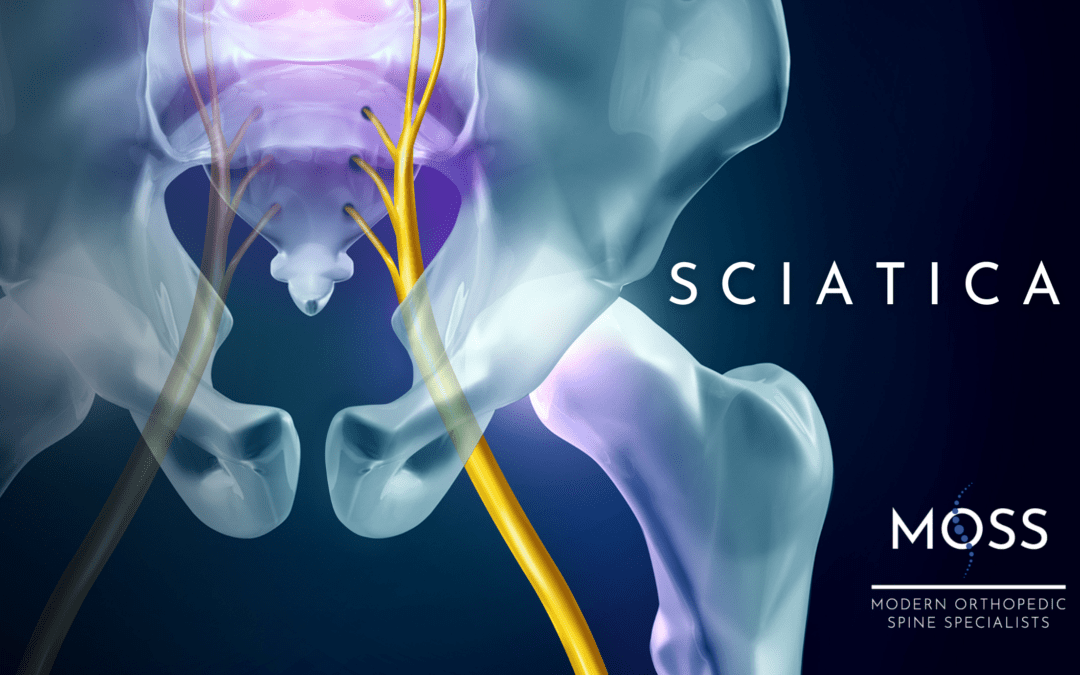Have you ever heard someone complain about their “sciatica acting up” and wondered what they meant? In this post, we will discuss what that means and what treatment options are available. Wonder no more!
THE SCIATIC NERVE
Nerves have the very important role of relaying information from your brain and spine to all parts of the body; they also receive information from the body and relay it to the spine and brain. Involved in many processes at once, our nerves help us to react to stimuli and our environment and keep our body working properly.
The sciatic nerve originates in your lower back and branches through your hips, buttocks, and down both legs to the toes and soles of your feet. It is the largest and longest nerve in your body and is composed of five nerve roots from the lower spine — L4, L5, S1, S2, and S3 — that join together to serve the skin and muscles of your thighs, legs, and feet.
At its largest point, the sciatic nerve is as thick as man’s thumb! And as it travels down the leg, it splits into two nerves at the knee — the tibial nerve and the common peroneal nerve, which serve the legs and feet.
WHAT IS SCIATICA?
Severe pain and/or neurologic symptoms, such as numbness, tingling, or weakness, originating in your lower back and radiating to your buttocks, and legs are often termed sciatica. These symptoms travel along the path of the sciatic nerve and depending on which of the five nerve roots is compressed (pinched), symptoms may be experienced at different parts of the thigh, leg, and foot. Not all pain that travels down the leg is sciatica; it is sciatica only if it is caused by an irritated or compressed sciatic nerve.
Radiculopathy — a range of symptoms, such as pain, numbness, tingling, and/or weakness that result from a pinched nerve — is most commonly seen along the sciatic nerve distribution pattern, but it is also seen along other nerves.
WHAT CAUSES SCIATICA?
Different conditions can cause or contribute to irritation, inflammation, or compression of the sciatic nerve, such as:
- Spondylolisthesis – When a vertebra slips out of its normal position onto another vertebra. If it pinches the sciatic nerve, sciatica can occur.
- Spondylosis – A degeneration of the spine. Again, if it results in sciatic nerve compression or irritation, sciatica is possible.
- Bone Spurs – These are overgrowths that can occur on the vertebrae, which if located near the sciatic nerve, can trigger symptoms of sciatica.
- Herniated discs – If any of the discs near the sciatic nerve bulge or herniate, this could irritate and/or compress the sciatic nerve.
- Foraminal stenosis – A narrowing of the openings (foramina) where any of the sciatic nerve roots exit can cause compression and irritation of the sciatic nerve.
- Genetic and physical factors – Obesity, age (elderly), and height (those who are tall) are factors that seem to contribute to a greater risk of sciatica.
Sciatica is sometimes seen in pregnancy as a result of changes in weight, shifting of bones, pressure from an expanding uterus and growing baby, as well as other bodily changes seen in pregnancy.
- Positional Causes – Sitting for long periods of time with poor posture or bending forward or sideways repeatedly can contribute to sciatica.
Your doctor can help to identify the cause of your sciatica and discuss treatment options. An MRI is usually performed to determine the cause of sciatica and the extent of damage as this will assist in evaluating what treatment options are indicated for your specific situation.
WHAT TREATMENT OPTIONS ARE AVAILABLE FOR SCIATICA?
Treatment options vary and depend on the severity and what is causing the sciatica. Your doctor is a valuable resource for determining and discussing possible treatments tailored to your individual circumstances.
If sciatica is mild, a few days of rest and cold packs applied to your lower back for several minutes a day for a couple of days, and then heat packs for the rest of the days can bring relief.
If, however, pain is more severe and unrelieved, other options are available:
Medication –
- Nonsteroidal anti-inflammatory drugs (NSAIDs)- Help reduce pain and inflammation. Naproxen (Aleve), aspirin, and ibuprofen (Advil).
- Analgesics- Help relieve pain. Acetaminophen (Tylenol).
- Muscle relaxants – Relax muscles, helping to reduce tension and pain.
- Steroids – Help reduce inflammation. These can be taken orally or administered by your doctor as an epidural injection.
- Nerve pain medication – These work specifically to block pain caused by damaged nerves.
Physical Therapy – A physical therapist can recommend stretches and exercises to help reduce pressure and irritation on the sciatic nerve. Physical therapy can be used alone or in conjunction with medications to relieve sciatica.

Surgery – If all other forms of therapy do not prove to be effective and symptoms persist, or there is evidence of nerve damage, sciatica can be addressed surgically.
As a member of the North American Spine Society and the American Academy of Orthopedic Surgeons, Dr. Armen Oganesian can discuss your options so you can decide what works best for you. He and his team are here to guide and support you every step of the way so you can return to a pain-free and active life!
For an individual consultation, contact Dr. Arman Oganesian at The Modern Spine Specialists today! Please contact The Modern Spine Specialists at 805-370-0748, or email us at info@themodernspine.com.
You can also visit our office at:
250 Lombard Street
Thousand Oaks, CA 91360


Recent Comments